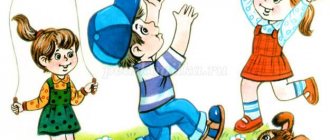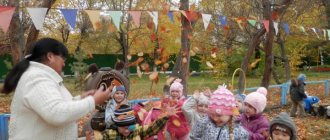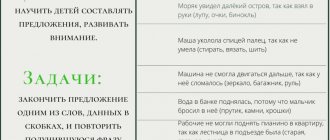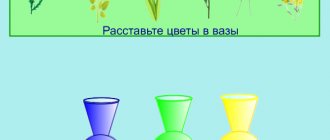Sedentary play in kindergarten as a form of physical development work
Preschoolers move a lot during the day in kindergarten: they learn dance moves with a music director, do physical education, and do exercises in a group and on walks. Teachers teach preschoolers outdoor games in order to expand their gaming experience, because children prefer other entertainment in independent activities . The attention of children of the 21st century is captured by television and computer technology. The guys relax after classes and on weekends, playing mobile applications or watching cartoons.
Modern children spend a lot of time in front of television screens
Sedentary games are games with little activity intensity. They contain all the basic movements: walking, running, jumping, squats, swings, throwing, etc. The purpose of holding sedentary games in kindergarten is to teach preschoolers a playful way to reduce physical activity. How often children are scolded for not being able to calm down instantly after a frisky game! But this is a natural state; the child, due to the characteristics of the nervous system, is unable to regulate emotional and muscular arousal as directed. During their stay in kindergarten, children learn that every outdoor game has a completion stage - a short period of time during which physical activity gradually decreases. Children remember that intense play is followed by calm play.
The low-movement game “Ladushki” creates a good mood and helps to calm down after increased activity.
In addition, sedentary games are carried out as a form of change of activity in classes in a small room: in visual activities, cognitive and speech development. During these classes, children are in a sitting position, and outdoor games are recommended to prevent overexertion and fatigue. Of course, the game is chosen to be calm and held near the students’ workplaces.
Tip: if the content of the game corresponds to the topic of the lesson, this will arouse additional interest among the children.
For example, during a drawing lesson “Mouse” in a younger group, you can play the game “Tsapki”. The leading role of the teacher is the cat. He stretches his arms forward, palms down, and reads a joke (“There are mice gathered under my roof…”). Children play the role of little mice, placing their fingers under the “cat’s paws.” As soon as the joke is over, the children must sharply remove their fingers so that the cat does not catch the mice. At the end of the game, the teacher invites the children to take their jobs and draw for each of them a mouse that was able to escape from the cat.
Children enjoy playing games with animal characters, such as cat and mouse.
Like any form of activity in kindergarten, sedentary games are aimed at the diversified development of pupils. In addition to forming habits for a healthy lifestyle, these games introduce children to folk traditions: the text and characters are taken from folklore. Games can be aimed at developing reaction, attentiveness, and memory. Sedentary games can be played with the entire group of students at the same time, so that a sense of collectivism arises in the children.
Table: tasks of sedentary games in different age groups
| Age group of children | Tasks |
| First junior/nursery (1.5–3 years) |
|
| Second youngest (3–4 years) |
|
| Medium (4–5 years) |
|
| Senior and preparatory (5–6 and 6–7 years old) |
|
The game “Dwarfs and Giants” develops auditory attention: children perform movements only in response to agreed commands
Types of sedentary games
Low mobility games are classified according to their content:
- Plotless games. The rules do not provide for division into roles, and there is no script in the game. Plotless games are based on completing tasks: find, repeat, remember, transfer, change, etc. These games develop attentiveness, memory, and motor skills.
Plotless games are often perceived by children as a kind of challenge to their abilities: “Can you do it like me?” And they like it, because every child copies the actions of adults in everyday life, wants to be as skillful as their parents and educators. When my kids were little (3 and 4 years old), calming them down after loud play was easy with imitation games. “Guys, I know how to assume the poses of sea animals! Can you repeat it?" There was no need to persuade, the children joined in the game with pleasure.
In the game "Shadow" children take poses shown by the leader
- Story games. The rules are based on a fairy-tale or everyday situation. The scenario assumes a distribution of roles: the leader is a cat, the participants are sparrows, for example. Story games are accompanied by poetic text or the performance of a short song. Children learn expressive role-playing in these quiet games, as well as develop reaction speed and coordination with words. In story games, it is recommended to use role-playing hats and masks, medallions with images of characters. There are few story games with low mobility. The finished collections feature mostly quiet games without roles. Tip: Try changing the rules of high- and medium-mobility story games so that the movements in the game have a low intensity. For example, story games with catching participants (“Wolf and Hares”, “Bear and Bees”, “Cat and Sparrows”) become sedentary if scattered running is replaced with calm actions. The hares are standing - the wolf can catch them. If the bunny sits down, he is in the house. Guys can hide from the leader by covering their eyes with their palms, covering their heads with a scarf, placing their hands in a “house” above their heads. In such games, the participants should be located in a circle, and the leader should be located inside it, but not in the center (so that everyone can see).
In the sedentary version of the game “The Wolf and the Hares,” the rabbit participants do not run away from the leader, but cover their eyes with their palms
- Folk games are fun based on fairy tales, accompanied by folklore texts. Sedentary games use songs, nursery rhymes and jokes (rhythmic short stories with game movements). Russian folk games instill in children a sensitive attitude to the traditions of the country, a love for their native nature. The popular game “Ring” can be defined as medium-moving: the one who received the ring tries to run to the leader, and the rest of the participants catch up with him and try to hold him. It is possible to reduce the intensity of the game by simplifying the task of the player with the ring. The presenter does not move far from the participants sitting in a row, but retreats one step. Thus, to win, the person who receives the ring needs to get up and take a step towards the leader.
The folk game “Ring” develops reaction speed in children
Our ancestors carried out various outdoor activities, in accordance with the seasons. In folk games, motifs associated with the calendar rituals of the Slavs have been preserved. Summer outdoor games contain movements that imitate field work. Autumn is dedicated to harvesting. Winter games are “violent” because at this time of year the peasants were free from working in the fields. In spring games the sun is invited.
Round dancing games at a calm pace with imitation of the movements of field work are carried out during walks
Calm, entertaining tasks
It is advisable to alternate active competitions with calm competitions that require attention, intelligence and ingenuity. In small rooms they are easy to carry out so that children enjoy playing in them, they should be fun and include fun tasks.
Inside out
The presenter pronounces the words, the children arrange the letters in reverse order, write the resulting word, for example, having heard “pencil case”, the child writes “lanep”, the word table - “lot”. Use a variety of words appropriate to the age of the players.
New fairy tale
Children are invited to turn into good wizards to help the sad story. Choose any fairy tale with a sad ending, and then ask the children to come up with a happy ending. Prepare your props and act out the scene.
Speak without hesitation
Participants receive a piece of paper with a picture, and the child who reads it the fastest wins.
Drawing blindly
Two teams participate, the players must draw a car blindly, the children take turns blindfolded and asked to draw one part of the car.
The one who is more like the real one wins.
Guess the song
This is a competition in which groups of children are given cards depicting various objects, animals, plants and things from famous songs.
Teams must guess which songs are encrypted in the pictures, the drawn train can mean the song “Blue Car”, the red-haired boy can mean the song “Red, Red, in a Mask”, the image of a mammoth can mean “Song about the Mammoth”. Caring parents can always make their children's holidays interesting if they take a creative approach to organizing it. A selection of fun games for children will help them with this!
Card index of sedentary games in kindergarten
Games based on folklore material are played with younger pupils. It is recommended to use musical accompaniment for sedentary games: instrumental melodies at a slow tempo, folk songs, recordings of nature sounds.
Older preschoolers often play outdoor games during independent study. A musical background also helps to orient them in the need to transition from high-intensity play to sedentary play. The music sounds at a fast pace - the games are appropriate, the music is slow - it’s time to play more calmly.
The selection of games presented below is based on the program by N. E. Veraksa “From birth to school” and the methodological manual by O. E. Gromova “Outdoor games for children of the Federal State Educational Standard for Education”.
The game must correspond to the age and interests of the students
Games for children 1.5–4 years old
In the first and second junior groups, the following sedentary games are recommended:
- “All the kittens washed their paws”;
- “Where are the pens”;
- “Once upon a time there were bunnies”;
- "Bunny";
- "Carousels";
- “The cat came to the stove”;
- “The cat lets out its claws”;
- "Ladushki";
- “It flies - it doesn’t fly”;
- “Mice and the Cat”/“Tsapki” (option where the mice are the children’s fingers);
- "Find a toy";
- "Find your color";
- “Two met...”;
- "Blow up, bubble";
- "Sun and Rain";
- "Silence";
- “Don’t wake the bear!”;
- “Cold - warm”;
- "Humpty Dumpty";
- “The king walked through the forest”;
- “These are eyes, here, here!”
Examples of collections of games with detailed descriptions for pupils of younger groups:
- Card index of sedentary games in the first junior group (Sorokina T.S.);
- Games of low mobility with children of the second younger group (Tararukhina T.V.).
Photo gallery: examples of cards with game descriptions
Game “Where are the pens?” designed for very young children, it is recommended to play it first in subgroups of 2-3 people
The game "Bunny" develops gross motor skills of children
“Ladushki” is learned in pairs: a child and a teacher
The game “The Rain Came Out for a Walk” develops reaction speed and fine motor skills
The game “Find Your Color” develops children’s attention
“Blow up, bubble!” - a popular game in preschool educational institutions, it is played during classes, holidays, walks
In the game “Sunshine and Rain”, children move rhythmically and learn to play with an attribute (umbrella)
Children practice walking in a column in the game “Silence”
Toy search games develop children's attention
Ri is performed in the form of a round dance with movements according to the text
The game based on the poem “Humpty Dumpty” is aimed at relieving muscle tension
Games for children 4–7 years old
With pupils of the middle, senior and preparatory groups, you can conduct a variety of sedentary games, including:
- "Rope";
- "Balloon";
- “Where did you knock?”;
- "Prohibited movement";
- "Mirror";
- "How are you?";
- "Dwarfs and Giants";
- “Who is missing?”;
- "Ring";
- “Who am I in the family?”;
- "Linen";
- "Slow Turtle"
- “The sea is rough!”;
- "Find yourself a partner";
- “Find and remain silent”;
- “You can’t see anything”;
- “Nose-ear-nose”;
- "On the path";
- "Trip to Moscow";
- “Edible-inedible”;
- "Three movements";
- "Weathervane"/"Four Elements";
- "Ball".
An example of a card index of games for older preschoolers can be seen here (author - O. S. Syapkaeva).
Photo gallery: cards with game descriptions
The game “Rope” promotes the development of beautiful posture and the development of a sense of balance
The game “Fishing Rod” develops attentiveness and reaction speed, trains in jumping on the spot
The Balloon game develops speech and motor skills at the same time.
By playing Mirror, children develop attentiveness
The game “Forbidden Movement” develops auditory attention and memory
In the game “How are you living?” children are given freedom to depict movements in the text
"Dwarves and Giants" - another fun game for attentiveness and reaction speed
There are different versions of the game “Ring”; in the sedentary version, the person who receives the ring does not need to run away
“The Sea is Rising” is one of the most popular low-mobility games
In the calm version of the game “Find Yourself a Mate,” running is replaced by walking
In the game “On a Level Path,” children improve their ability to coordinate movements with text
There is probably no child who does not know the game “Edible-Inedible”
The game “Four Elements” uses numbers to replace words, which activates children’s mental activity
“Who am I in the family?” - an example of a combination of a cognitive element in an outdoor game
The game “Find and remain silent” is often played at the final stage of a physical education lesson.
Carrying out sedentary games in kindergarten
Low mobility games in preschool educational institutions are organized several times during the day:
- in the final part of a physical education lesson or leisure time, in order to bring the pupils into a relatively calm state;
- on a walk after helping with cleaning or beautifying the area, after high mobility play;
- in the middle of a cognitive and artistic lesson to relieve mental and muscle tension;
- outside routine moments: after a walk, after cleaning a group room, during quiet activities in the afternoon;
- at matinees and holidays.
Low mobility games are held during thematic leisure time
The teacher selects low-mobility games in advance in accordance with the age of the children and the topic of the lesson (leisure activity). If a teacher plans to play a new game with children, he must first learn the rules and text accompaniment of the game, and remember the movements. It is unacceptable to read the contents of the game from the sheet! It is allowed to show children a short video of how this game plays out (no longer than 1 minute), and offer to get acquainted with the rules. The teacher's emotional story about the game wins children over and motivates them.
The teacher passes on his own gaming experience to the children, teaches the children what he himself can do.
Table: stages of sedentary play
| Stage of the game | Junior groups | Middle, senior, preparatory groups |
| Gathering for the game |
| |
| Introductory stage, motivating beginning |
| |
| Explanation | The teacher explains the game during its implementation: shows the movements, gives a signal to change actions. |
|
| A game |
|
|
| Completion |
|
|
Duration of sedentary games
The duration of the game from the moment the participants gather is determined taking into account the age of the children:
- in younger groups - no more than 10 minutes;
- on average - 12 minutes;
- in senior and preparatory classes - 15 minutes.
Table: time plan for the game “Sunshine and Rain” in the first junior group
| Stage of the game | Collection and introductory stage: receiving a parcel with an umbrella | Explanation of the rules | A game | Completion: the teacher takes a photo of the children with an umbrella to send in an envelope to the fabulous sender of the parcel |
| Duration | 1 minute | 1 minute | 4 minutes | 1 minute |
The guys learn a new attribute and learn to play with it during their first acquaintance with the game “Sunshine and Rain”
Table: time plan of the game “The sea is agitated, once!” in the middle group
| Stage of the game | Gathering and introductory stage: King Neptune comes to visit the guys | Explanation of the rules | A game | Completion: Neptune talks to the guys about how they liked the sea game |
| Duration | 1 minute | 2 minutes | 6–7 minutes | 2 minutes |
In the game “The Sea Is Worried”, children not only strike poses, but also fantasize about how they can imagine a sea animal
Table: time plan for the game “Flies - doesn’t fly” in the senior group
| Stage of the game | Collection and introductory stage: letter from insects from a fairy-tale forest (pictures of all animals and objects that consider themselves to fly) | Explanation: conversation about questions about the rules of a familiar game | A game | Completion: the guys make up an answer to the insects, attaching cards of flying objects |
| Duration | 2 minutes | 2 minutes | 7–8 minutes | 2 minutes |
The game “Flies - doesn’t fly” consolidates children’s knowledge about objects in the world around them
Table: example of a summary of a low-mobility game for children 5–6 years old
| Author | Nutikova E., teacher at MBDOU D/s No. 198, Novokuznetsk, Kemerovo region. |
| Name | "Amanita" |
| Purpose of the game |
|
| Preparing for the game |
|
| Material | A cone made of plastic or cardboard 40–50 cm high, to the top of which is attached a circle of red cardboard with specks drawn on it in white gouache (circle diameter 10–15 cm). |
| Progress of the game |
|
| Quote from: https://www.maam.ru/detskijsad/podvizhnaja-igra-maloi-podvizhnosti-muhomor.html | |
The following outline outline describes the main stages of organizing and conducting outdoor games with preschoolers.
Advantages of development:
- description of the production of gaming material (fly agaric);
- adding a more complicated version of the game;
- indicating at the final stage of the game the transition to independent creative activity (drawing with crayons).
The shortcoming of the notes is seen in one of the goals set for the game: “development of musical ear and perception.” It is not clear how ear for music develops during the described game. Children recite poetic text, but no songs are sung. The author does not mention the use of musical accompaniment. The use of a tambourine cannot be considered a musical element, as a prohibiting signal is given according to the rules of the game.
For the round dance game “Fly Agaric”, G. Vikhareva’s song “Fly Agaric Mushrooms” can be used.
How to fill out a summary of low mobility games for children 5-6 years old in the senior group
Teacher's notes
The teacher’s reference table is filled out according to the following points:
- Author of the program (name of teacher, kindergarten number, city and region).
- Name of the exercise.
- Goals and objectives.
- Necessary materials.
- Progress of the game.
- Summarizing.
The value of sedentary games is to create positive emotions in children and relieve stress and muscle tension after active activities. Low-intensity exercises are an excellent option for your child to keep busy independently in the company of their peers.






